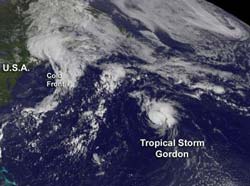NASA sees System 93L explode into Tropical Storm Gordon

The GOES-13 satellite captured this visible image of newborn Tropical Storm Gordon on Aug. 16 at 1145 UTC (7:45 a.m. EDT). Credit: NASA GOES Project<br>
System 93L started out on August 10 as a tropical wave and associated low pressure area, that moved off the African coast into the eastern Atlantic. Over the last six days it moved west across the Atlantic Ocean and had its ups and downs in terms of organization and development.
On August 15 at 5 p.m. EDT, it strengthened into the Atlantic Ocean hurricane season's eighth tropical depression, just 15 hours after infrared data from the Atmospheric Infrared Sounder (AIRS) instrument onboard NASA's Aqua satellite identified a strong banding of thunderstorms around the center of circulation and northwest of the center. That banding was an indication of organization and strengthening.
Aqua's AIRS instrument captured another infrared image System 93L as it was strengthening into tropical depression 8, and before it became Tropical Storm Gordon. The image was taken on Aug. 15 at 12:53 p.m. EDT, and showed strong bands of thunderstorms to the north and west of the center of circulation where cloud tops were so high into the atmosphere that they were as cold as -63 Fahrenheit (-52 Celsius). When thunderstorms that make up tropical cyclones reach such heights, they likely contain heavy rainfall, and are indicative of a lot of strength within the cyclone.
Tropical Depression 8 continued to intensify and by August 16, it had strengthened into Tropical Storm Gordon, the seventh tropical storm of the Atlantic Ocean hurricane season.
At 5 a.m. EDT, Tropical Storm Gordon had maximum sustained wind near 40 mph (65 kmh), and some strengthening is expected, according to the National Hurricane Center (NHC). In fact, the NHC noted that Gordon could become a hurricane over the weekend of August 18-19 because the storm is expected to track over warm water and encounter very little wind shear.
The center of Tropical Storm Gordon was located about 585 miles (940 km) east of Bermuda, near latitude 32.2 north and longitude 54.8 west. Gordon is moving toward the north-northeast near 14 mph (22 kmh) and is expected to turn northeast and east, heading back into the north central Atlantic Ocean.
The NOAA GOES-13 satellite captured a visible image of newborn Tropical Storm Gordon on August 16 at 1145 UTC (7:45 a.m. EDT). The image shows that Gordon is a small storm. Tropical-storm-force winds extend outward from the center to only 25 miles (35 km) and those are mostly east of the center of circulation. The GOES-13 image shows that small central dense overcast has formed near Gordon's center. The image was created at NASA GOES Project at the NASA Goddard Space Flight Center in Greenbelt, Md. NASA's GOES Project creates images and animations from NOAA GOES satellite data.
The NHC expects Gordon to track east into the Atlantic, and it may affect the Azores.
Media Contact
More Information:
http://www.nasa.govAll latest news from the category: Earth Sciences
Earth Sciences (also referred to as Geosciences), which deals with basic issues surrounding our planet, plays a vital role in the area of energy and raw materials supply.
Earth Sciences comprises subjects such as geology, geography, geological informatics, paleontology, mineralogy, petrography, crystallography, geophysics, geodesy, glaciology, cartography, photogrammetry, meteorology and seismology, early-warning systems, earthquake research and polar research.
Newest articles

Webb captures top of iconic horsehead nebula in unprecedented detail
NASA’s James Webb Space Telescope has captured the sharpest infrared images to date of a zoomed-in portion of one of the most distinctive objects in our skies, the Horsehead Nebula….

Cost-effective, high-capacity, and cyclable lithium-ion battery cathodes
Charge-recharge cycling of lithium-superrich iron oxide, a cost-effective and high-capacity cathode for new-generation lithium-ion batteries, can be greatly improved by doping with readily available mineral elements. The energy capacity and…

Novel genetic plant regeneration approach
…without the application of phytohormones. Researchers develop a novel plant regeneration approach by modulating the expression of genes that control plant cell differentiation. For ages now, plants have been the…





















